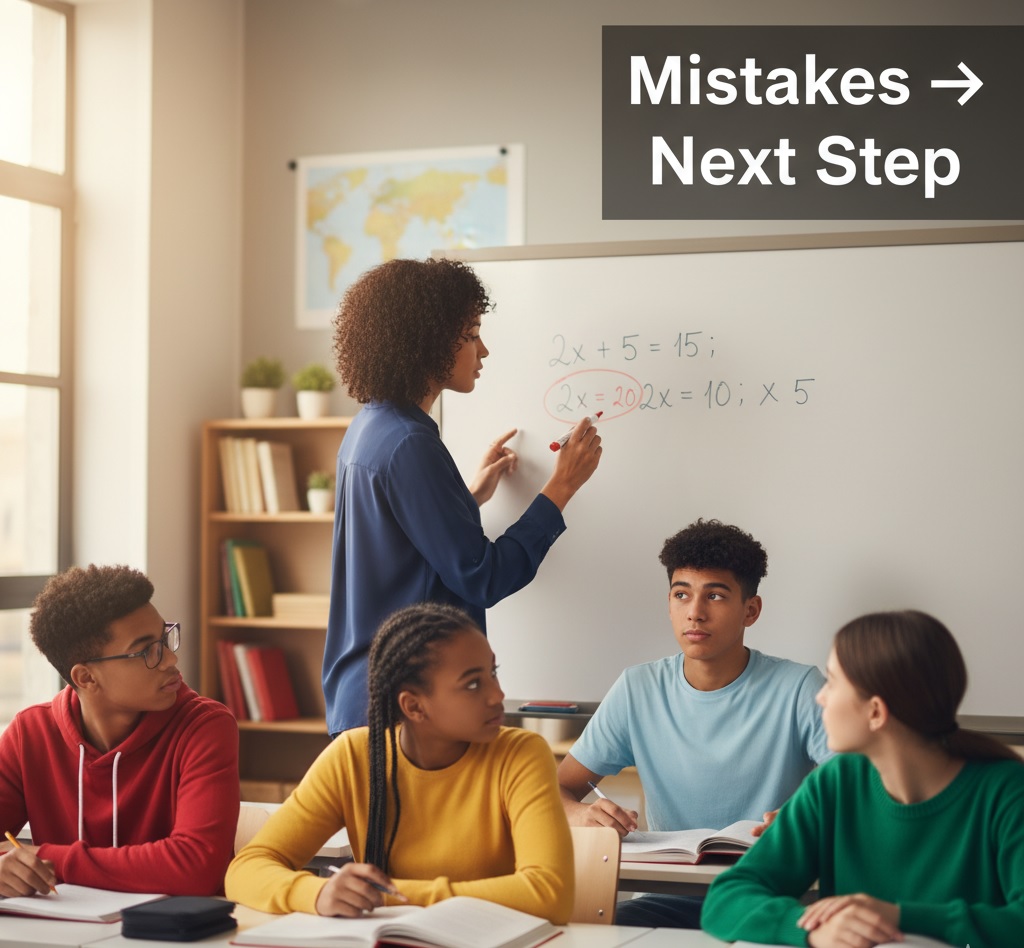
How to Help Students Learn from Mistakes
Errors map the next step in instruction. Research on desirable difficulties shows that modest challenge through spacing, interleaving, and generation supports retention and transfer. Work on productive failure adds a clear lesson: short attempts before teaching can lift conceptual learning when followed by direct instruction.
Pretesting and other retrieval attempts help later study, even when first answers miss the mark. Reviews on formative feedback stress precise, timely, and nonjudgmental guidance.
Studies on classroom error climate show links with student engagement and lower fear. The signal is consistent: treat errors as information and teach students how to act on it.
Table of Content
- How to Help Students Learn from Mistakes
- Build an error-safe climate
- Plan tasks that invite thinking before teaching
- Pretests and retrieval checks
- Feedback that fixes thinking
- Erroneous examples and error analysis
- Self-explanation
- Emotions and motivation after setbacks
- Assess growth without punishing risk-taking
- Adapt by age and subject
- Implementation playbook
- Measure impact
- What the numbers say
- Real-class examples
- Common Mistakes and fixes
- Conclusion
- FAQs
- Sources
Build an error-safe climate
Set the norm
Say it on day one: “If you’re not making mistakes, the work may be too easy here. We share and fix them together.” The message lowers threat and invites honest work. Students speak up more when they know missteps are part of the process.
Model your own fixes
Solve a problem in front of the class. Make a common slip on purpose. Then show how you notice it and repair it. This approach reflects findings from error management training, where detection and correction support transfer to new tasks.
Use process-focused language
Keep attention on the idea, not the person. Try: “Where did the reasoning drift?” or “What assumption drove that step?” Students learn the habit of tracing cause, not defending self-worth.

Plan tasks that invite thinking before teaching
Productive failure sequence (Attempt → Teach → Compare)
Run a short challenge first, then teach the target method, and finish by contrasting both. Students see why the expert method works and where early ideas fell short. Reviews of this pattern report stronger gains for understanding when the attempt phase leads into clear instruction.
Design tips
Keep stakes low. Pick tasks that surface common misconceptions. End with one independent item to consolidate. A tight flow—attempt, teach, compare—keeps momentum and clarity.
Pretests and retrieval checks
Simple loop
Start a lesson with 3–5 ungraded pretest items. Teach the concept. Return items with one-line explanations and add one fresh question. Pretesting and test-enhanced learning show gains over re-reading, so this loop pays off without extra time.
Timing and spacing of feedback
Use both immediate and delayed feedback. Immediate feedback helps early skill formation. Delayed feedback can lift final performance through spacing and reflection, including work with vocabulary in younger grades. Match timing to purpose.
Feedback that fixes thinking
Specific, neutral, actionable
Good feedback names the misconception, links it to a principle, and shows the fix. Keep it short and usable.
-
“You distributed the negative to only the first term. Apply it to both; then re-check line 3.”
-
“Your claim is strong; add the study that supports it, with author and year.”
A major review on formative feedback highlights these features and warns against vague praise or simple right/wrong marks.
Handling multiple-choice lures
Plausible distractors can linger. Add corrective feedback after items or during review. This step keeps the testing benefit and cuts lure carryover.
Erroneous examples and error analysis
Protocol
Present a worked solution with one realistic slip. Ask three questions:
-
Where is the first wrong step?
-
Why is it tempting?
-
Which rule corrects it?
Then show a clean solution. Students learn to spot patterns and avoid repeat mistakes.
Fast formats
-
Mistake hunts: Three short responses—excellent, subtle error, flawed. Students rank and justify.
-
Error gallery: Pin anonymized samples with diagnosis cards: error type → cause → correction → prevention plan.
Self-explanation
Three prompts
Brief self-explanations build stronger links in memory and expose gaps. Use any of these:
-
“What goal does this step achieve?”
-
“Which principle makes it valid here?”
-
“If this step were wrong, what would fail later?”
Short written answers—one or two sentences—are enough. Pair with correct and erroneous examples for extra lift.
Emotions and motivation after setbacks
Normalize struggle
Your tone sets the room. Thank students for surfacing errors. Ask what the error teaches and what to try next. Work on error climate connects this stance with better mood and sustained effort.
Family messages
Parent views of failure shape student mindsets. Share a short note for families: ask what the mistake reveals, praise the attempt to fix it, and plan a next step. This keeps support consistent across home and school.
Assess growth without punishing risk-taking
Two-column revisions
Left page: original attempt. Right page: corrected work with a one-sentence diagnosis. Grade the right page and the diagnosis. This format rewards thinking, not only final accuracy.
Revision windows
Offer a short re-attempt after feedback. The pause adds spacing and gives students time to reflect. Over a unit, expect fewer repeat errors.
Error logs
Students log date, task, error type, cause, correction, and a prevention plan. Review logs during conferences or stations. Patterns become visible, and repeat mistakes drop.
Adapt by age and subject
Early years
Keep pressure low. Use think-alouds with simple slip models: “I forgot to count this block—how did that change my total?” Short error hunts build confidence and attention to process.
Middle and secondary
Increase pretests, retrieval checks, and erroneous examples in math, science, and languages. Use brief peer talk before whole-class synthesis to widen participation.
Higher education
Open labs or seminars with prediction prompts or short attempt phases, then teach and compare. Students see why the expert path works and how to test their own ideas.
Implementation playbook
Day-one norm
“You’ll see me share and fix my own mistakes. I’ll ask you to share and fix yours. Errors show us what to learn next.” Post it. Repeat it.
Pretest loop
-
Four ungraded questions → collect.
-
Teach the concept.
-
Return with one-line explanations.
-
One re-try item.
Erroneous example routine
-
Show a solution with one plausible slip.
-
Students mark the first wrong step, state why it attracts, and repair it.
-
Compare to a clean solution.
-
Capture a prevention tip.
Feedback sentence frames
-
“Where it drifted: … What it means: … What to try next: …”
-
“Assumption X fails when condition Y changes. Test Y first; then redo step Z.”
Safer MCQ practice
Present the correct answer and a short reason after each item or during a review block. This curbs lure effects and keeps the testing advantage.
Measure impact
Error recurrence rate
Track how often a targeted misconception reappears a week later. A steady drop signals that feedback is landing.
Transfer checks
Add one new-context item to each quiz. Retrieval practice supports transfer when spaced across a unit.
Climate pulse
Every two weeks, one question on a 1–5 scale: “I can share mistakes here without feeling put down.” Watch the trend and adjust routines.
What the numbers say
-
Feedback effect sizes: Syntheses within the Visible Learning program often report feedback among higher-impact influences on achievement (figures around d≈0.70–0.80 across varied contexts). Treat the figure as directional and context-dependent. The practical move is steady, specific feedback that students use.
-
Error management training: A meta-analysis across 24 studies (N≈2,183) reported a mean effect of d=0.44, larger for transfer (d=0.56) and largest for adaptive transfer (d≈0.80). The pattern fits classroom goals that value flexible performance.
-
Testing and pretesting: Retrieval practice and pretests improve later learning over re-study. Gains appear even when first attempts miss most items.
Real-class examples
Two-tries notebooks (math or science).
First attempt on the left, corrected work on the right, plus a one-line diagnosis. Grade the right page and the diagnosis. Expect cleaner work within a week as patterns become clear.
Prediction first (science).
Ask for a prediction and a short rule before a demo. After the demo, compare predictions with results and state the winning rule.
Find the first slip (language or math).
Post a short response that hides one mistake. Students mark the first wrong move and write a fix. Five minutes, strong payoff.
One-minute self-explanations.
At the end of practice, ask: “Which step does the main work, and why?” This habit boosts precision and transfer.
Family feedback note.
Send a short handout: “What did the error teach? What comes next?” Keep the loop consistent across home and school.
Common Mistakes and fixes
-
Long attempt phase. Time-box it. Follow with clear instruction and guided practice.
-
Marks without action. Add a one-line diagnosis and a next move.
-
MCQs with no corrections. Provide item-level feedback so distractors do not stick.
-
Mindset talk with no strategy. Pair encouragement with pretests, self-explanations, and revision cycles.
Conclusion
Treat mistakes as data, not identity. Set a safe tone. Plan short struggles before teaching. Give feedback that shows what drifted, why it drifted, and how to fix it. Add pretests, self-explanations, and erroneous examples to make thinking visible. Over time, learners stop hiding errors and start using them. That shift builds accuracy, confidence, and transfer.
FAQs
1) Will pretests lower confidence if students miss most questions?
Frame them as curiosity checks and keep them ungraded. Students see progress once corrections arrive, and later scores tend to rise.
2) Should feedback always be immediate?
Use both. Immediate feedback helps new skills settle. Delayed feedback supports long-term memory through spacing.
3) How do I stop multiple-choice practice from teaching wrong options?
Give item-level corrections with brief reasons. This reduces lure carryover and keeps test benefits.
4) Do erroneous examples risk spreading bad habits?
Not when paired with prompts and a clean comparison. Students learn to spot patterns and repair them.
5) What is a fast routine I can add this week?
Run the ten-minute pretest loop and use two-column revisions on the next task. Small steps, steady gains.
Sources
-
Bjork, E. L., & Bjork, R. A. (2011). Desirable difficulties in theory and practice.
-
Kapur, M. (2022). Fail, flip, fix, and feed: Rethinking productive failure.
-
Richland, L. E., Kornell, N., & Kao, L. S. (2009). The pretesting effect.
-
Roediger, H. L., & Karpicke, J. D. (2006). Test-enhanced learning.
-
Shute, V. J. (2008). Focus on formative feedback.
-
Booth, J. L., et al. (2016). Erroneous examples in algebra learning.
-
Zhao, H. (2016). Learning with incorrect worked examples in equation solving.
-
Chi, M. T. H. (1989; 1994). Self-explanation and learning from examples.
-
Steuer, G., et al. (2013–2024). Classroom error climate and student outcomes.
-
Haimovitz, K., & Dweck, C. S. (2016). Parents’ views of failure and children’s mindsets.
-
Hattie, J. (2008; 2012). Visible Learning (feedback syntheses).
-
Keith, N., & Frese, M. (2008). Error management training: Meta-analysis.


